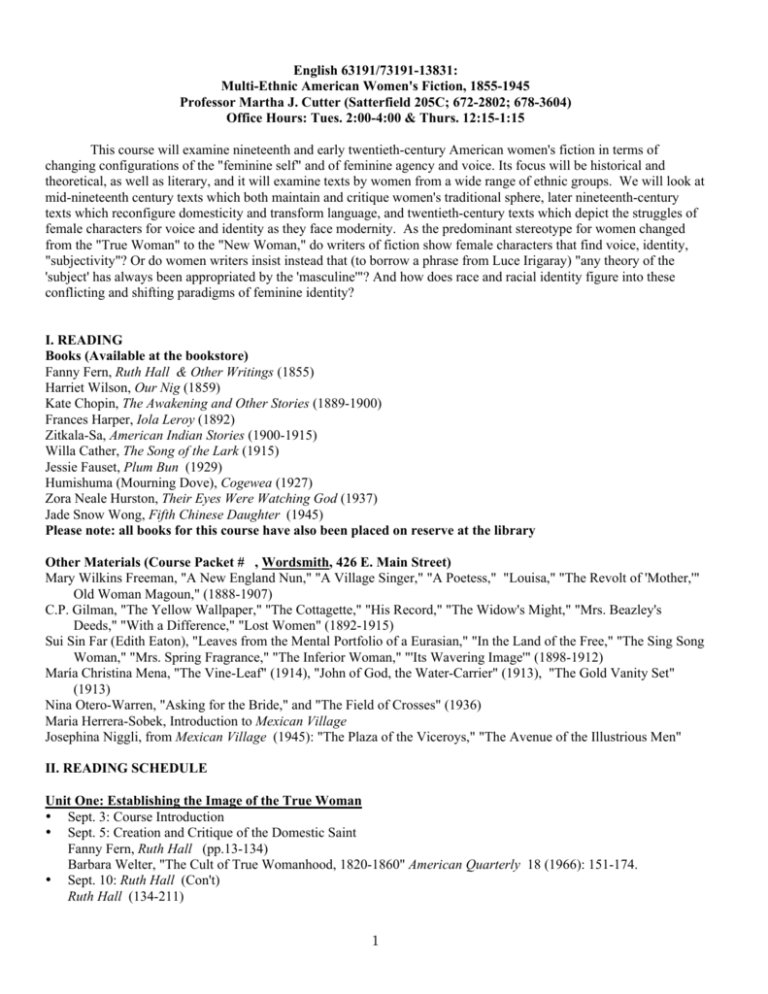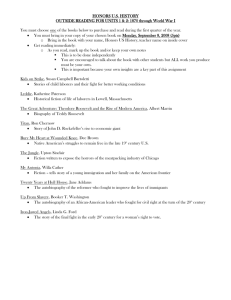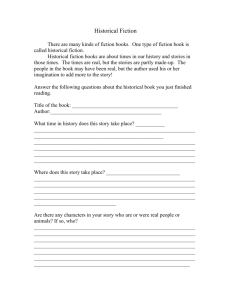Multi-Ethnic American Women's Fiction, 1855-1945
advertisement

English 63191/73191-13831: Multi-Ethnic American Women's Fiction, 1855-1945 Professor Martha J. Cutter (Satterfield 205C; 672-2802; 678-3604) Office Hours: Tues. 2:00-4:00 & Thurs. 12:15-1:15 This course will examine nineteenth and early twentieth-century American women's fiction in terms of changing configurations of the "feminine self" and of feminine agency and voice. Its focus will be historical and theoretical, as well as literary, and it will examine texts by women from a wide range of ethnic groups. We will look at mid-nineteenth century texts which both maintain and critique women's traditional sphere, later nineteenth-century texts which reconfigure domesticity and transform language, and twentieth-century texts which depict the struggles of female characters for voice and identity as they face modernity. As the predominant stereotype for women changed from the "True Woman" to the "New Woman," do writers of fiction show female characters that find voice, identity, "subjectivity"? Or do women writers insist instead that (to borrow a phrase from Luce Irigaray) "any theory of the 'subject' has always been appropriated by the 'masculine'"? And how does race and racial identity figure into these conflicting and shifting paradigms of feminine identity? I. READING Books (Available at the bookstore) Fanny Fern, Ruth Hall & Other Writings (1855) Harriet Wilson, Our Nig (1859) Kate Chopin, The Awakening and Other Stories (1889-1900) Frances Harper, Iola Leroy (1892) Zitkala-Sa, American Indian Stories (1900-1915) Willa Cather, The Song of the Lark (1915) Jessie Fauset, Plum Bun (1929) Humishuma (Mourning Dove), Cogewea (1927) Zora Neale Hurston, Their Eyes Were Watching God (1937) Jade Snow Wong, Fifth Chinese Daughter (1945) Please note: all books for this course have also been placed on reserve at the library Other Materials (Course Packet # , Wordsmith, 426 E. Main Street) Mary Wilkins Freeman, "A New England Nun," "A Village Singer," "A Poetess," "Louisa," "The Revolt of 'Mother,'" Old Woman Magoun," (1888-1907) C.P. Gilman, "The Yellow Wallpaper," "The Cottagette," "His Record," "The Widow's Might," "Mrs. Beazley's Deeds," "With a Difference," "Lost Women" (1892-1915) Sui Sin Far (Edith Eaton), "Leaves from the Mental Portfolio of a Eurasian," "In the Land of the Free," "The Sing Song Woman," "Mrs. Spring Fragrance," "The Inferior Woman," "'Its Wavering Image'" (1898-1912) María Christina Mena, "The Vine-Leaf" (1914), "John of God, the Water-Carrier" (1913), "The Gold Vanity Set" (1913) Nina Otero-Warren, "Asking for the Bride," and "The Field of Crosses" (1936) Maria Herrera-Sobek, Introduction to Mexican Village Josephina Niggli, from Mexican Village (1945): "The Plaza of the Viceroys," "The Avenue of the Illustrious Men" II. READING SCHEDULE Unit One: Establishing the Image of the True Woman • Sept. 3: Course Introduction • Sept. 5: Creation and Critique of the Domestic Saint Fanny Fern, Ruth Hall (pp.13-134) Barbara Welter, "The Cult of True Womanhood, 1820-1860" American Quarterly 18 (1966): 151-174. • Sept. 10: Ruth Hall (Con't) Ruth Hall (134-211) 1 • • Susan Harris, "Inscribing and Defining: The Many Voices of Fanny Fern's Ruth Hall,"19th-Century American Women's Novels: Interpretive Strategies (Cambridge: Cambridge University Press, 1990) 111-127. Martha Cutter, "Language and Feminine Subjectivity in American Women's History, 1850-1930." Sept. 12: African American Perspectives on the Domestic Saint Harriet Wilson, Our Nig Sept. 17: Our Nig (Con't) Jill Jones, "The Disappearing 'I' in Our Nig," Legacy 13 (1996): 38-53. Unit Two: The Image Cracks • Sept. 19: Revolting Women Mary Wilkins Freeman, "The Revolt of Mother," "A Village Singer,""A Church Mouse," "A Poetess,""Louisa,""A New England Nun,""Old Woman Magoun" Martha Cutter, "Frontier of Language: Engendering Discourse in 'The Revolt of "Mother,"'" American Literature 63 (1991): 279-291. • Sept. 24: Racial and Sexual Identities at the turn into the Twentieth Century Kate Chopin, The Awakening Patricia S. Yaeger, "'A Language Which Nobody Understood': Emancipatory Strategies in The Awakening," Novel: A Forum on Fiction 20 (1987): 197-219. Michele Birnbaum, "'Alien Hands': Kate Chopin and the Colonization of Race," American Literature 66 (1994): 301-23. • Sept. 26: Voices of Subversion? Kate Chopin, "Elizabeth Stock's One Story,""La Belle Zoraide," "Désirée's Baby" Catherine Lundie, "Doubly Dispossessed: Kate Chopin's Women of Color," Louisiana Literature 11 (1994): 12644. • Oct. 1: Resisting the Silencing of Race Frances E.W. Harper, Iola Leroy • Oct 3: Iola Leroy (Con't) John Ernest, "From Mysteries to Histories: Cultural Pedagogy in Frances Harper's Iola Leroy," American Literature 64 (1992): 497-518. • Oct. 8: Deconstruction and Reconstruction of feminine identities C.P. Gilman, "The Yellow Wallpaper," "The Cottagette," "His Record," "The Widow's Might," "Mrs. Beazley's Deeds," "Spoken To," "With a Difference," "Lost Women" Paula A. Treichler, "Escaping the Sentence: Diagnosis and Discourse in 'The Yellow Wallpaper,'" Tulsa Studies in Women's Literature 3 (1984): 61-77. Susan Lanser, "Feminist Criticism, 'The Yellow Wallpaper,' and the Politics of Color in America," Feminist Studies 15 (1989): 415-441. Unit Three: Racial Perspectives on Feminine Stereotypes • Oct. 10: Zitkala-Sa's Autobiographical Writings Zitkala-Sa, "Impressions of an Indian Childhood," "The School Days of an Indian Girl," "An Indian Teacher Among Indians" Martha Cutter, "Zitkala-Sa's Autobiographical Writings: The Problems of a Canonical Search for Language and Identity in Native American Writing," MELUS 19 (1994): 31-44. • Oct. 15: Zitkala-Sa's Fiction Zitkala-Sa, "The Soft-Hearted Sioux," "The Trial Path," "A Warrior's Daughter," "A Dream of Her Grandfather" • Oct. 17: Co-Authorship and "Minority" Discourse Mourning Dove, Cogewea: The Half-Blood • Oct. 22: Race, Racing, and Cultural Identity Mourning Dove, Cogewea: The Half-Blood (Con't) • Oct. 24: Border Identities in Asian American Fiction Sui Sin Far (Edith Eaton), "Leaves from the Mental Portfolio of a Eurasian," "In the Land of the Free," "The Sing Song Woman," Mrs. Spring Fragrance," "The Inferior Woman," "'Its Wavering Image'" Elizabeth Ammons, "Audacious Words: Sui Sin Far's Mrs. Spring Fragrance," Conflicting Stories (New York: Oxford University Press, 1991) 105-120. 2 • • Oct. 29: Cultural and Sexual Indoctrination Jade Snow Wong, Fifth Chinese Daughter Oct. 31: Resistance to ideologies of race and gender? Elaine Kim, "Life Among the 'Loyal Minority': Second-Generation Chinese American Autobiography," Asian American Literature (Philadelphia: Temple University Press, 1982) 58-72. Unit Four: The New Woman, Race, and Feminine Identity • Nov. 5: Willa Cather and Stereotypes of Femininity Cather, The Song of the Lark • Nov. 7: Willa Cather and "Women's" Art Sharon O'Brien, Willa Cather: The Emerging Voice (New York: Oxford, 1987): 403-427. • Nov. 12: The New Woman and the True Woman in Jessie Fauset's Fiction Fauset, Plum Bun • Nov. 14: Passing, Language, and Racial Discourses in Plum Bun Jacquelyn McLendon, "A 'Bad' Fairy Tale: Ironic Inversion in Plum Bun," The Politics of Color in the Fiction of Jessie Fauset and Nella Larsen (Charlottesville: Univ. Press of Virginia, 1995) 27-52. • Nov. 19: Ethnic Discourses: Cather and Fauset • Nov. 21: Racial and Feminine Identities in Early Mexican American Women's Writing María Christina Mena, "The Vine-Leaf," "John of God, the Water-Carrier," "The Gold Vanity Set"; Nina Otero-Warren, "Asking for the Bride," and "The Field of Crosses" • Nov. 26, 28: Thanksgiving Break (No Class; Work on Final Paper!) • Dec. 3: Beyond Stereotypes? Zora Neale Hurston's Fiction Hurston, Their Eyes Were Watching God • Dec. 5: Silence, Voice, and Vision in Their Eyes Were Watching God Lorraine Bethel, "'This Infinity of Conscious Pain': Zora Neale Hurston and the Black Female Literary Tradition," Modern Critical Interpretation of Their Eyes Were Watching God, ed. Harold Bloom (New York: Chelsea, 1987) 9-18. Missy Dehn Kubitschek, "'Tuh de Horizon and Back': The Female Quest in Their Eyes Were Watching God,” Modern Critical Interpretation of Their Eyes Were Watching God, ed. Harold Bloom (New York: Chelsea, 1987) 19-33. • Dec. 10: Representations of Mexican American Identity Josephine Niggli, "The Plaza of the Viceroys," "The Avenue of the Illustrious Men" Maria Herrera-Sobek, "Josephina Niggli: A Border Writer and Precursor of Chicano/a Literature," introduction to Mexican Village (Albuquerque: University of New Mexico Press, 1994): xvii-xxxi. • Dec. 12: Course Conclusion: The Meaning of "Ethnicity" III. REQUIREMENTS A) Class Participation (10%). This class will be centered on discussion of texts by students, and as such it necessitates that all students participate in class on a regular basis. Class participation is a requirement for successful completion of this course. In preparation for our discussions, I expect you to complete all of the primary reading assignments on time, as well as any secondary essays I assign. Attending class is also helpful if you wish to earn this 10% of your grade. B) Response Paragraphs (15%). From time to time I will require you to prepare for class discussion by writing a brief response to a topic I or a student has raised. These responses must be typed. If appropriate, I may xerox some of them for class discussion. C) Class Presented Paper (25%) (6-8 pages) (See handout). D) Final paper (50%): Students are required to write a final seminar paper. This will be due on Dec. 18, by 5:00. You can use your class presented paper as a basis for your longer paper (15-20 pages), or work on an entirely different project (10-20 pages). This paper should involve primary as well as secondary sources. 3






